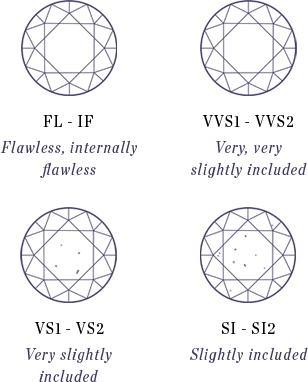DIAMOND ESSENTIALS. THE 4C'S
Cut
The art of diamond cutting is an offshoot of the science of optics. Early diamond cutters worked both as lens and diamond crafters searching for the qualities that unlocked the light trapped in a diamond's beauty. In order for a diamond to excel in light performance, it must first be “cut,” a word that refers to a diamond’s shape (i.e., round, square, emerald, etc.) When diamond dealers talk about “cut” they are referring to the shape of a stone, not its craftsmanship. Depending on its shape, a diamond’s five parts must have exact mathematical dimensions and proportions in order to achieve maximum diamond light performance. At RockHer we believe in carrying the highest quality diamonds. Our Intelligent Diamond Search Rosi automatically eliminates all diamonds that have any tiny defects of craftsmanship.
No matter what the cut, or shape, of a diamond, it will usually have five parts:
1. Table- a flat top plane.
2. Crown- a faceted slope that moves outward to connect the stone’s top to its midsection.
3. Girdle- a thin intersection plane between the stone’s top and bottom that runs parallel to its table.
4. Pavilion- a faceted slope that moves inward to the stone’s bottom point.
5. Cutlet- bottom point, often considered a facet.
Carat
Carats are often understood as an indicator of size. But nothing could be farther from the truth. Two identical-weight and identical-shape diamonds can look quite different in size depending on how they are cut. Make sure you compare dimensions as well as weight.
Diamonds are the world’s most concentrated form of wealth. Gems are so light that they have their very own unit of weight called a “carat,” which is equal to 1/5th of a gram. Furthermore, a carat is subdivided into 100 points, so a 0.20 carat diamond might be called a 20-point diamond. A 141.75 carat diamond weighs just one ounce. Here is why you should never buy diamonds by weight alone. At one point there was too much emphasis being put on heavier diamonds. However, saving weight will sometimes sacrifice the beauty and sparkle of a diamond. Diamonds are now cut to show their full brilliance and not for their weight.
For example, say you have your heart set on a 1-carat diamond and its price is $15,000. Believe it or not, a .98 or .99 carat stone will cost you an estimated 20% less than the hefty per-carat price. Rosi our diamond algorithm will automatically disregard the human tendency to think of diamond size and locate these true diamond finds.
Color
Diamond is the only gem with a reputation for being colorless. The whiter a stone, the higher its value. Hence when jewelers and gemologists talk about diamond color, they are really talking about the lack of it. Luckily, these touches of color are hard, if not impossible, to see. And those that can be seen are light on the eye. In fact, the only time you may begin to detect tint is when faintly colored stones are placed next to perfectly color-free ones. Usually, diamond color is visible only through contrast. The diamond trade uses a truncated D-to-Z alphabet system to rate stones for the presence of color. Although 23 grades are used, most are clustered into six groupings.
RockHer never offers diamonds with ratings below K. Diamond color is the area of value where cost-conscious consumers have the most leeway. If cut properly, diamonds with faintly detectable tints will hide their hue. The thing to remember is that diamonds can be colored, as well as colorless. However, the vast majority are classifiable as near colorless diamonds.
Clarity
Diamonds have the longest and toughest creation of any gemstone. Given their million-year genesis, diamonds by nature, have tiny, usually microscopic traces of carbon and minerals inherent within their pure crystal form. These identifying characteristics, known as inclusions, are often unnoticeable and difficult to spot unless viewing through a microscope. They can be tiny or large depending on the stone and will vary from stone to stone.
There are 12 clarity grades in use today, clustered into four groups. The flaw-free stones at the top and the imperfect stones at the bottom. Here are the six levels from top down.
RockHer eliminates all stones with inclusions visible to the naked eye, allowing for a range of stones from FL through SI. This assures zero visibility of flaws to the naked eye.Rosi calculates the position of all clarity characteristics and eliminates stones whose flaws could be seen by the unaided eye, even if their grade indicates invisibility. At RockHer we pledge to selling what the trade calls only “eye-clean” diamonds.

